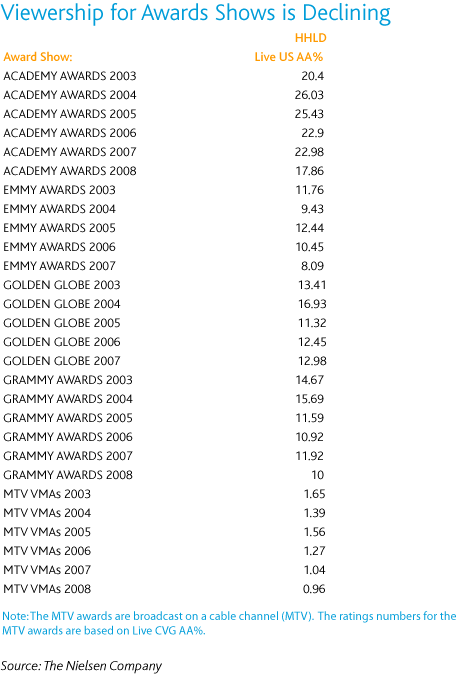Valentina Nucete, Nielsen Entertainment and Virginia Harvey, Nielsen Monitor-Plus
| SUMMARY: Despite waning viewership numbers—and a male audience that has gone MIA—award shows remain popular with advertisers, and even more so with artists who can see music sales climb as much as 700% one week after the show airs. |
The Grammy Awards, Academy Awards, MTV Video Music Awards, Emmy Awards and Golden Globe Awards represent the pinnacle of professional achievement in an artistic sense, and serendipitously, in a financial sense as well.
Knee-deep in the award season, Nielsen evaluated music sales data for the week prior to and following the Grammy Awards during the 2006-2008 seasons. Nine out of ten artists who won or performed at the Grammys earned the ultimate accolade—an increase in album sales. Three-quarters of those artists managed to spin a win into a jump in digital song sales as well.
| Two-thirds of participating artists enjoyed a sales boom of 50% or more… |
Great performances
For the 2008 Grammys, two-thirds of participating artists enjoyed a sales boom of 50% or more. Notably, British warbler Amy Winehouse hit a sales high note. After nabbing five awards, her week-after-airing sales of Back to Black climbed to 4.5 times those of the show week ‘115,000 vs. 25,000 units’.
Similar sales spikes were observed for the 2007 Grammys, with half of musical participants enjoying a sales push of 50% or more during the seven day post-show period. In an unprecedented revival, The Police reunited to cut a track titled Outlandos D’Amour that copped top sales honors with a 120% unit increase.
Future focus
The nominee list for the 2009 Grammys features a number of familiar faces—including Madonna, the Eagles, John Mayer, Maroon 5 and Rascal Flatts—who have appeared in two of the last three award shows as performers, winners or both. In a rare triple play, 2009 candidates Bruce Springsteen (Best Rock Song) and John Legend (Best Rap/Sung Collaboration) either performed or won Grammys in 2006, 2007 and 2008.
Springsteen’s record sales following a Grammy win or appearance enjoyed a bump anywhere from 37% to 200%. Legend’s results were even more impressive, with after-show sales ranging from 77% to 700%. If the past is predictor of future success, expect to see them both at the podium again this year.
| Just earning a nomination proved powerful enough to move the song sales dial… |
Movie magic
Just earning a nomination in the Academy Awards proved powerful enough to move the song sales dial during the critical post-program week. After winning the 2008 Best Original Song Oscar, digital downloads of the Glen Hansard and Marketa Irglovasong entry Falling Slowly rose some 207% (42,000 vs 14,000 the pre-show week). The movie soundtrack album Once, which featured the song, also saw sales soar from 19,000 to 47,000 copies.
In prior years, the Melissa Etheridge entry I Need to Wake Up from the film An Inconvenient Truth and the Houston/Coleman/Beauregard collaboration It’s Hard Out There for a Pimp from the movie Hustle and Flow grew sales by 87% and 275%, respectively. The soundtrack albums for both films increased by 59% and 77%, respectively, and other Academy Award-nominated entries in the Best Original song category followed suit, posting gains in both song and soundtrack album sales.
Ads up
Who are you wearing? Red carpet coverage has become almost as big a draw as the Oscars. The names of top designers, jewelers, hair stylists and make-up artists trip off the tongue of your average consumer. So, it’s no surprise that a department store like JCPenney holds the number three top-spending position among Academy Award advertisers for the past five years courtesy of a 2008 spend of almost $11 million, roughly one-third more than in 2007.
The top slot in award show advertising support goes to General Motors: five years running at the Academy Awards and the Grammys, three years at the Emmys, and four years at the Country Music Awards.
Worth it
L’Oreal lives its classic slogan, apparently believing award show advertising is “worth it”. The company dominated at the 2005 Golden Globes, spending $4.4 million on advertising. Procter & Gamble put its best face forward at the MTV Video Music Awards, reigning as top sponsor every year except 2006.
Apple chose to debut its groundbreaking iPhone at the Academy Awards in July 2007, five full months prior to product release, spending a whopping $5 million on three TV spots. Even the government got into the award advertising game, spending its way onto the MTV Video Music Awards’ top10 advertiser list for 2004-2008 thanks to a massive recruitment ad budget.
Encore ads
Success breeds success, or at least cultivates encore advertisers. Keen observers will note that many advertisers from the February 2008 Grammy Awards also ran schedules during the 2009 Grammy nomination announcements. For example, sponsor P&G slated seven spots for total air time of 2 minutes 30 seconds. Other repeat advertisers included Sprint and Time Warner. A highlight of the announcements was a digital duet featuring Best Buy and the Apple iPod in a 30-second spot.
| Award shows are not the “draw” they used to be… |
Viewer attrition
Despite robust advertiser support, award shows are not the “draw” they used to be. The MTV Video Music Awards now skew to younger females, with a rapidly dwindling male audience. The downward spiral can be seen in Academy Award viewership, the Emmy Awards and the Grammys, with only the Golden Globes managing to hold its audience fairly constant.

As for what’s behind the downturn, there are any number of theories. Some blame a dated format that drags on. Some find the scripts predictable and boring. Some find the talent too old and unrelatable. Some believe the awards themselves are pretty much predetermined by the box office results. Take your pick as to the main motivation, it’s undeniable that consumers are taking a pass.
The 2008 Oscar show averaged a 10.7 rating in adults 18-49, down 24% from the 2007 audience and 14% below the previous low, suggesting that all age groups are losing interest. The zenith of Academy Award broadcasts was the 1998 show when Titanic won a record-tying 11 awards, drawing 55 million U.S. viewers.
Chicks and flicks
On a more upbeat note, the 2007 Oscar numbers were up 3% over the prior year, particularly among women 18-34 and 18-49. Overall, the telecast drew 8% more viewers among adults 18-34, achieving a 12.9 rating that was its best performance among this demographic in five years.
Perhaps explaining the attraction of the Oscars to advertisers, Claritas and Spectra drafted a very appetizing profile of the average viewer, describing her as an upper-middle-income to upper-income female, at least 35 years old, college educated and residing in the New England, Mid-Atlantic and Pacific regions.
Critics aside, award shows are earning rave reviews from advertisers and the retailers who benefit from a telecast-driven sales lift for winning and performing artist offerings.



